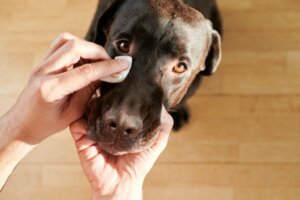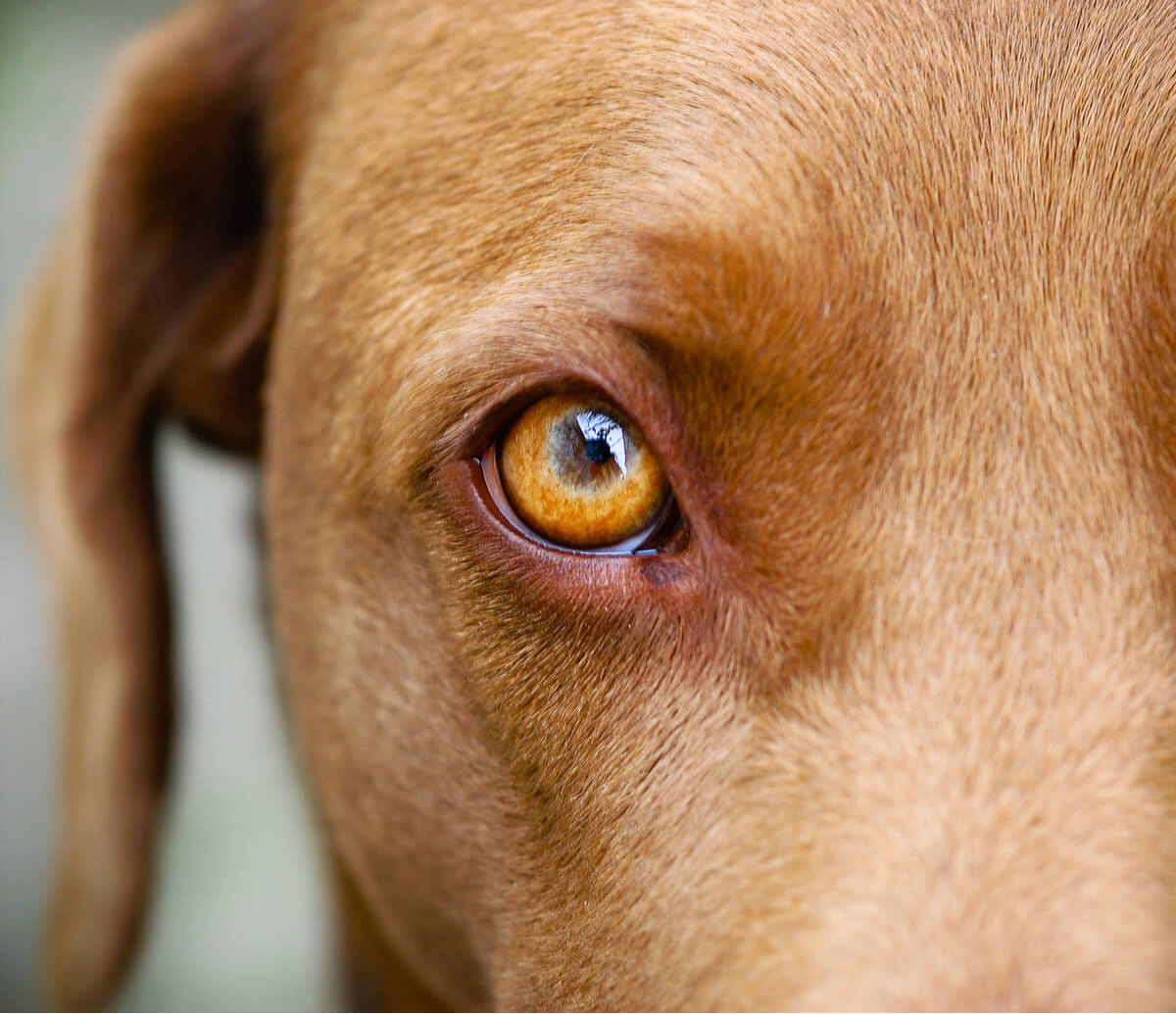6 Types of Eye Discharge in Dogs (and What They Mean)

Eye discharge in dogs isn’t usually too serious and is relatively easy to treat. However, there are exceptions, and you should know how to differentiate between a normal ocular secretion and signs of an underlying problem in the pet.
So, in this article, we’ll bring you the most common reasons why a dog can tear excessively (or secrete other substances) and what to do about it. Don’t miss it, because detecting any dog eye disease in time can mean the difference between minor damage and total blindness.
6 types of eye discharge in dogs
Depending on what is affecting the eye, the secretions will be different. Firstly, we will describe normal tearing so you can differentiate it from other colorations and consistencies, more typical of diseases and injuries. Keep reading!
1. Eye mucus
Dogs’ eyes secrete substances from the corner of their eyes, as do humans and other animals. This tearing is a way to expel dust and dirt from the environment that sticks to the surface of the eyeball. When these secretions dry and harden, they usually take on a brownish colour and are commonly known as eye mucus, also known as “sleep” in humans.
It’s normal to find “sleep” or eye mucus in dogs’ eyes in the mornings and after long naps, just as can happen with humans. It isn’t an indication of illness if it isn’t accompanied by other symptoms.

2. Excessive tearing (epiphora)
Excessively watery eyes, with a clear, liquid discharge, are a sign that something is irritating the eyeball or the mucosa of the eyelid. It’s necessary to consult with the vet, because the causes are varied and some of them can be serious:
- Allergies.
- Foreign bodies in the eye: Even if you don’t see what has got into your dog’s eye, it’s very likely to be red, inflamed and constantly watering.
- Entropion or ectropion: The first term refers to the reversion of the eyelid inwards, so the eyelashes rub against the cornea and cause irritation. Ectropion is the opposite, in which the eyelid is folded outwards and the mucosa is irritated, stimulating tearing.
- Glaucoma: This is an increase in intraocular pressure. You’ll notice that the eye is swollen, red and tears excessively. It’s a serious condition and causes great pain to the animal, in addition to the risk of blindness.
- Trauma to the eye: Either by contusion or ulceration (due to sharp or pointed objects). It’s common to find it in dogs, as they sometimes play carelessly and hit their faces on the ground or high grass (also playing with other dogs).
- The presence of irritants in the environment, such as volatilized chemicals or pollution.
3. Reddish-brown eye discharge in dogs
These secretions are normal, as dogs’ tears contain a substance called porphyrin that reddens on contact with the air. It’s more easily seen in dogs with white coats and may give the impression that something is wrong, but it’s their usual eye discharge.
If you want to remove the red streaks from your dog’s face, you should wash the area with a damp cloth several times a day. Keep in mind, however, that this is a cosmetic issue, not a health problem.
4. Greyish or white discharge
This discharge is typical of a condition which affects the lacrimal glands, and in which the immune system attacks and destroys the tear glands. Since the eye isn’t able to produce enough tears, it compensates by secreting mucus for lubrication.
At the vet’s clinic, the Schirmer test will quickly determine if your dog’s tear secretion is insufficient.
This disease requires treatment as soon as possible, otherwise it can lead to blindness or eye ulcers. In addition, it causes great discomfort in the animal and sometimes changes the pigmentation of the cornea.
5. Yellowish or greenish tearing
When a dog produces yellowish or green eye secretions, which are also thick and gelatinous, it’s very likely to be suffering from an infection. This can be primary or secondary to some other ailment, such as canine rhinotracheitis or kennel cough.
In this case, a visit to the vet is necessary, because you shouldn’t let the infection progress, and even less so if it’s secondary to another underlying health problem. If it isn’t properly resolved, then it’s very likely that the infection will recur.
6. Brown discharge
This type of secretion is often confused with the more reddish type, which is the one that contains porphyrin. When the dog produces excessive tears and they’re an earthy brown color, it may be due to a blockage of the nasolacrimal duct, which connects the eye to the nose.
The main causes of this discharge are foreign body obstruction, excess mucus, or breed-related conditions. Small and brachiocephalic dogs are more likely to suffer from this problem.

Again, it should be noted that this article is only intended to be informative and to help you recognise the signs that your dog may be suffering from with their eye condition. As you will have seen, the same eye discharges in dogs are caused by very different problems, so an accurate diagnosis can never be made at home.
Eye discharge in dogs isn’t usually too serious and is relatively easy to treat. However, there are exceptions, and you should know how to differentiate between a normal ocular secretion and signs of an underlying problem in the pet.
So, in this article, we’ll bring you the most common reasons why a dog can tear excessively (or secrete other substances) and what to do about it. Don’t miss it, because detecting any dog eye disease in time can mean the difference between minor damage and total blindness.
6 types of eye discharge in dogs
Depending on what is affecting the eye, the secretions will be different. Firstly, we will describe normal tearing so you can differentiate it from other colorations and consistencies, more typical of diseases and injuries. Keep reading!
1. Eye mucus
Dogs’ eyes secrete substances from the corner of their eyes, as do humans and other animals. This tearing is a way to expel dust and dirt from the environment that sticks to the surface of the eyeball. When these secretions dry and harden, they usually take on a brownish colour and are commonly known as eye mucus, also known as “sleep” in humans.
It’s normal to find “sleep” or eye mucus in dogs’ eyes in the mornings and after long naps, just as can happen with humans. It isn’t an indication of illness if it isn’t accompanied by other symptoms.

2. Excessive tearing (epiphora)
Excessively watery eyes, with a clear, liquid discharge, are a sign that something is irritating the eyeball or the mucosa of the eyelid. It’s necessary to consult with the vet, because the causes are varied and some of them can be serious:
- Allergies.
- Foreign bodies in the eye: Even if you don’t see what has got into your dog’s eye, it’s very likely to be red, inflamed and constantly watering.
- Entropion or ectropion: The first term refers to the reversion of the eyelid inwards, so the eyelashes rub against the cornea and cause irritation. Ectropion is the opposite, in which the eyelid is folded outwards and the mucosa is irritated, stimulating tearing.
- Glaucoma: This is an increase in intraocular pressure. You’ll notice that the eye is swollen, red and tears excessively. It’s a serious condition and causes great pain to the animal, in addition to the risk of blindness.
- Trauma to the eye: Either by contusion or ulceration (due to sharp or pointed objects). It’s common to find it in dogs, as they sometimes play carelessly and hit their faces on the ground or high grass (also playing with other dogs).
- The presence of irritants in the environment, such as volatilized chemicals or pollution.
3. Reddish-brown eye discharge in dogs
These secretions are normal, as dogs’ tears contain a substance called porphyrin that reddens on contact with the air. It’s more easily seen in dogs with white coats and may give the impression that something is wrong, but it’s their usual eye discharge.
If you want to remove the red streaks from your dog’s face, you should wash the area with a damp cloth several times a day. Keep in mind, however, that this is a cosmetic issue, not a health problem.
4. Greyish or white discharge
This discharge is typical of a condition which affects the lacrimal glands, and in which the immune system attacks and destroys the tear glands. Since the eye isn’t able to produce enough tears, it compensates by secreting mucus for lubrication.
At the vet’s clinic, the Schirmer test will quickly determine if your dog’s tear secretion is insufficient.
This disease requires treatment as soon as possible, otherwise it can lead to blindness or eye ulcers. In addition, it causes great discomfort in the animal and sometimes changes the pigmentation of the cornea.
5. Yellowish or greenish tearing
When a dog produces yellowish or green eye secretions, which are also thick and gelatinous, it’s very likely to be suffering from an infection. This can be primary or secondary to some other ailment, such as canine rhinotracheitis or kennel cough.
In this case, a visit to the vet is necessary, because you shouldn’t let the infection progress, and even less so if it’s secondary to another underlying health problem. If it isn’t properly resolved, then it’s very likely that the infection will recur.
6. Brown discharge
This type of secretion is often confused with the more reddish type, which is the one that contains porphyrin. When the dog produces excessive tears and they’re an earthy brown color, it may be due to a blockage of the nasolacrimal duct, which connects the eye to the nose.
The main causes of this discharge are foreign body obstruction, excess mucus, or breed-related conditions. Small and brachiocephalic dogs are more likely to suffer from this problem.

Again, it should be noted that this article is only intended to be informative and to help you recognise the signs that your dog may be suffering from with their eye condition. As you will have seen, the same eye discharges in dogs are caused by very different problems, so an accurate diagnosis can never be made at home.
All cited sources were thoroughly reviewed by our team to ensure their quality, reliability, currency, and validity. The bibliography of this article was considered reliable and of academic or scientific accuracy.
- Mauricci Bravo, R. A. (2017). Diagnóstico temprano de queratoconjuntivitis seca empleando la prueba lacrimal de Schirmer en caninos de Salaverry-Trujillo.
- Carbonell, J. M. M., & Suárez, E. M. M. (2009). Claves para el diagnóstico precoz del glaucoma. REDVET. Revista Electrónica de Veterinaria, 10(3), 1-14.
- Diez Prieto, I. Avances en el diagnóstico de las enfermedades oculares en el perro.
This text is provided for informational purposes only and does not replace consultation with a professional. If in doubt, consult your specialist.








